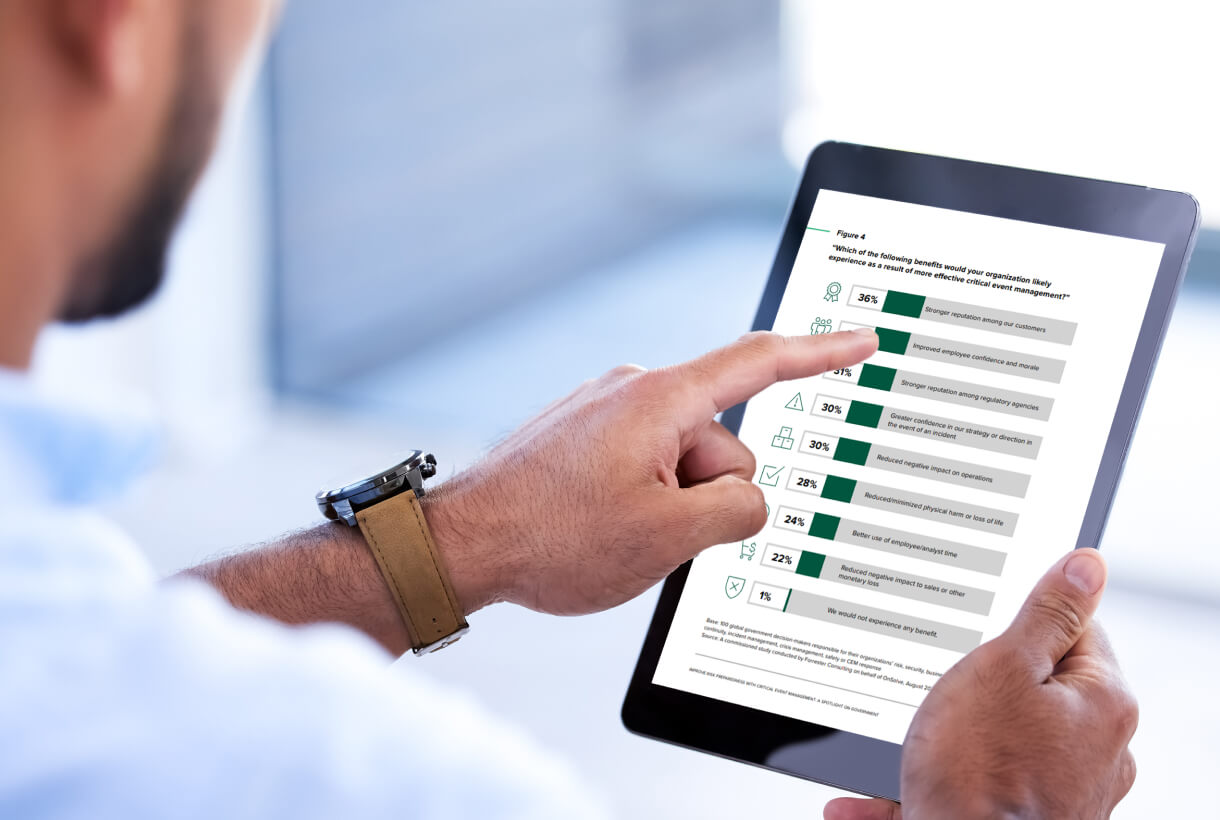Government agencies have a longstanding mission to protect the safety and security of their residents. In the last two years, that objective has turned more challenging. It’s difficult enough to handle a pandemic, but as soon as you layer other threats – severe weather, a data breach, civil unrest – things get complicated fast.
The growing volume of critical events means agencies of any size may find they’re underprepared, pushing them to improvise in the moment. However, reactive responses can lead to less-than-optimal results. In today’s unpredictable risk landscape, you have to get ahead of threats.
One answer to this problem is to continually evaluate and evolve your critical event management (CEM) strategy to improve preparedness and resilience. The following four steps will help you gain a fresh perspective on existing plans.
1. Acknowledge what you don’t know.
Underestimation of risk is widespread. While threats to your population’s welfare are always on your mind, agencies often fail to appreciate the true scope of risk, leaving them unaware and under-prepared, according to a commissioned study conducted by Forrester Consulting on behalf of OnSolve.
In fact, only 54 percent of government security and risk management professionals who responded to the study agree that risks and business disruptions can come from anywhere. And slightly more than half expect risk management to be more complex in two years, despite the undeniable rapid evolution of technology. Acknowledging these uncomfortable truths is the first step to making practical changes.
2. Identify your gaps.
Once you’ve recognized the disconnect, it’s time to get specific. Where are your agency’s points of vulnerability? Reflect on the strategy that underlies your action plan. Do you have the resources to support it? If you don’t have a means of maintaining awareness of existing and potential threats, you can’t effectively plan your defenses. The research bears this out – only 45 percent of respondents reported their risk management strategies as effectively measured or optimized. Here are two key questions to start your assessment:
- Are your risk management processes and the technology that supports them integrated throughout your organization or are your various departments operating in silos? Only 18 percent of agencies use an enterprise risk management team to lead CEM, and just one percent distribute responsibility across the entire organization. If all of the moving parts don’t work in unison, the machine is going to break when a critical event happens.
- Are you getting full value for your current CEM platform? You need technology with the capability to effectively monitor risk and improve your response to incidents. Just 38 percent of government respondents believe their CEM technology delivers maximum value. If this is the case for you, your agency isn’t receiving much return on investment. That’s cause for change.
3. Pinpoint the top benefits you’d expect from effective CEM.
In order to identify the benefits, reflect on your most recent major critical event. Where were your major areas of breakdown? How will improving CEM address the challenges you faced during that incident? The right technology can rectify those pain points.
Research demonstrates that optimized critical event management helps stakeholders achieve better outcomes. Here are a few of the expected benefits that accompany enhanced CEM, indicated by respondents to the study:
- 30% expect a reduction in the negative impact on operations.
- 36% expect a stronger reputation among customers.
- 33% expect improved employee confidence and morale.
- 28% expect reduced physical harm or loss of life.
This is only a sampling of the many areas where you can reap measurable advantages. When you can articulate those particulars for your agency, you’ll be in a better position to gain the buy-in of decision makers.
4. Plot your path to improvement.
Now it’s time to put it all into action. When you have a solid strategy and the technology to support it, you can better protect your people, places and property. This hinges on two major efforts:
- Drive interoperability: CEM strategy and risk management capabilities should complement each other across all facets of your organization. Piecemeal solutions are frustrating and ineffective. Instead, look for technology that can rapidly identify and analyze risk. It should then translate that information into action plans and communications strategies.
- Work from the inside-out: Internal data, external intelligence and predictive analytics must combine to deliver better outcomes. This means you need real-time event monitoring, AI, machine learning, continuous controls-monitoring tools and third-party risk intelligence. The right platform will deliver it all seamlessly.
Download the study Improve Risk Preparedness with Critical Event Management: A Spotlight on Government to understand more about the research results and how you can put them to work for your agency and your community.


